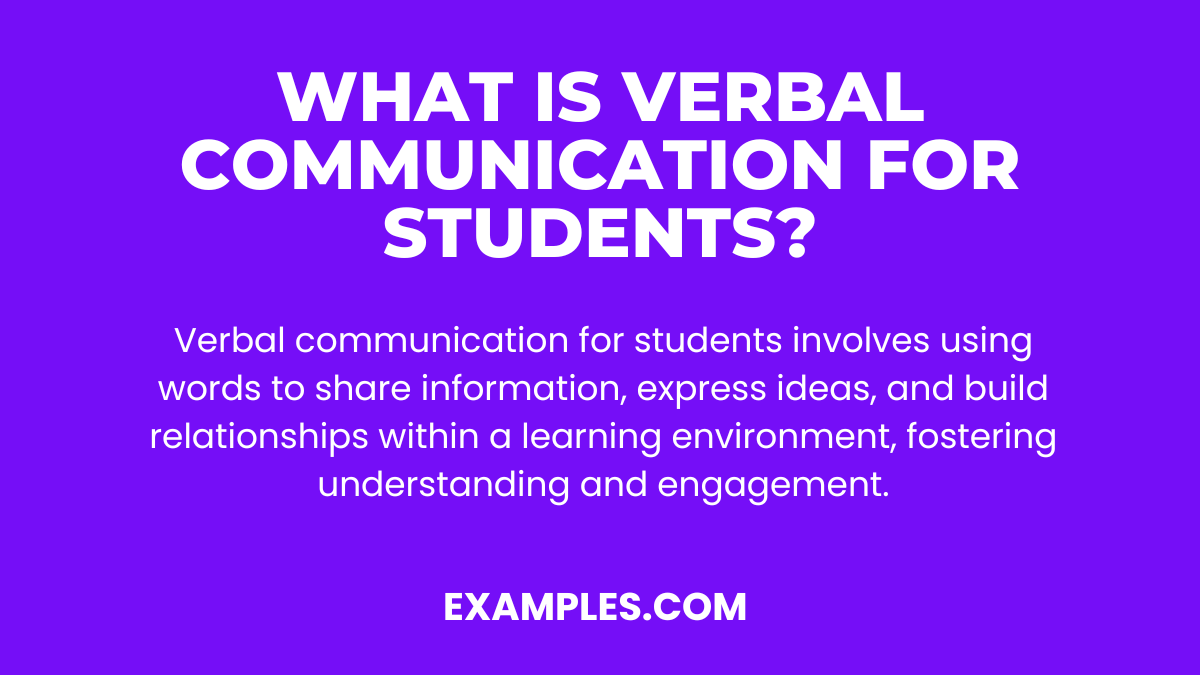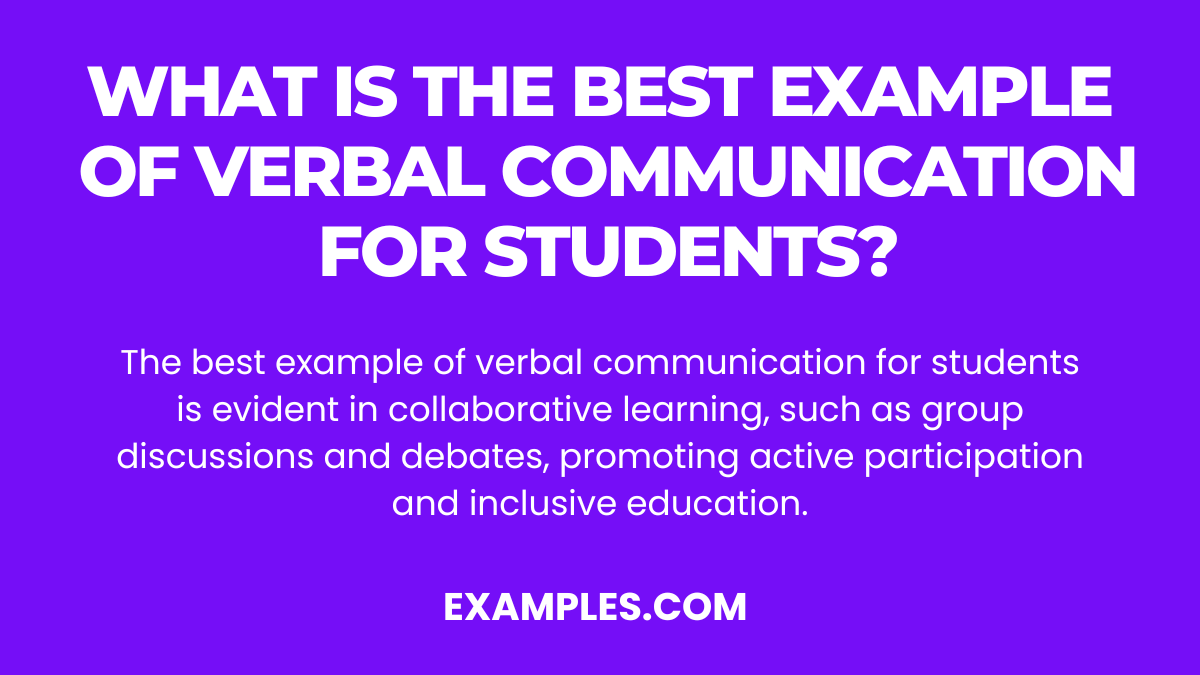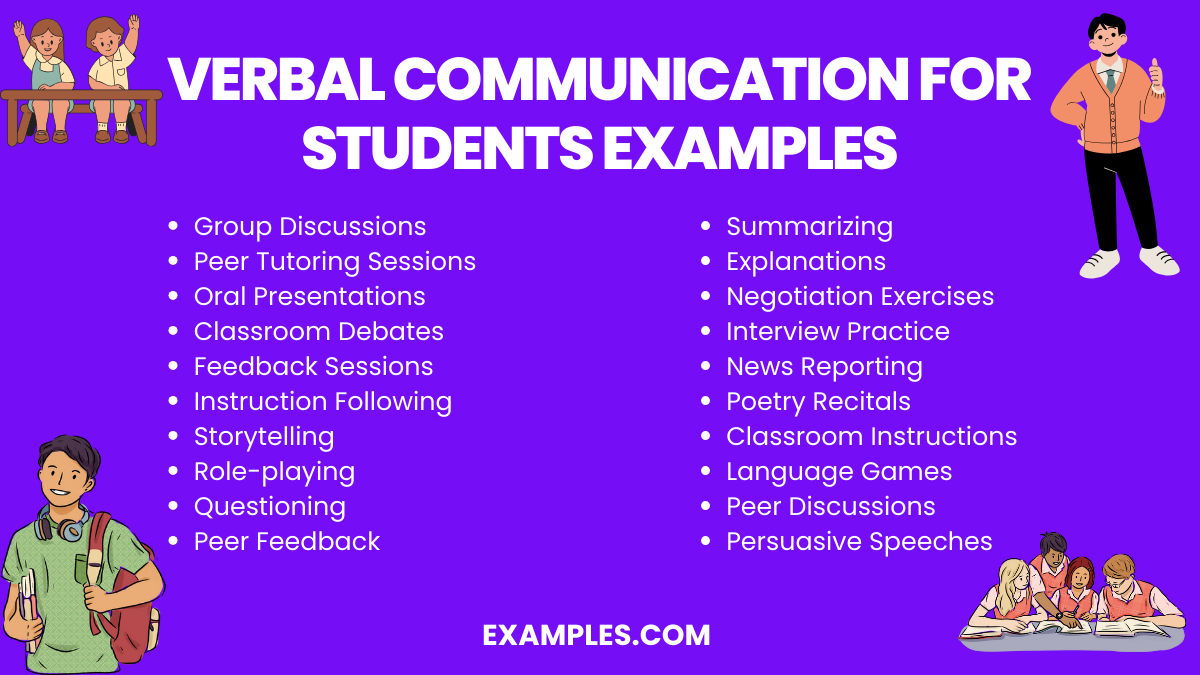Verbal Communication for Students
Embark on a journey through the nuances of student interaction with our comprehensive guide on Verbal Communication for Students. Uncover effective Communication Examples that resonate with learners, elevate understanding, and foster academic success. This guide is an invaluable resource for educators and students alike, seeking to enhance dialogue in educational settings through proven techniques and insightful examples.
Download Verbal Communication for Students in Classroom PDF
What is Verbal Communication for Students? – Meaning

Verbal Communication for Students refers to the use and understanding of words in a learning environment to share information, express ideas, and build relationships. It encompasses a range of interactions from classroom discussions to peer conversations. Including effective Verbal Communication Examples in teaching helps illustrate complex ideas, making them accessible and engaging for learners of all ages.
What is the Best Example of Verbal Communication for Students?

The best example of verbal communication for students is often seen in collaborative learning, where students engage in group discussions and problem-solving activities. Here, students not only share information but also articulate their thoughts, listen actively, and provide feedback. An effective instance might be a well-facilitated class debate where each student contributes their perspective, demonstrates listening skills, and adapts their language to the audience, promoting a dynamic and inclusive educational environment.
20 Verbal Communication for Students Examples

Delve into the dynamic world of student interactions with 20 distinct Verbal Communication for Students Examples. Understand What Percent of Communication is Verbal? and enhance your approach with effective Verbal Communication Techniques. Discover the Advantages and Disadvantages of Verbal Communication to foster understanding and adaptation. Grasp the essential Functions of Verbal Communication and the diverse Types of Verbal Communication integral to student life. Enhance your repertoire with essential Verbal Communication Skills and learn Ways to Improve Verbal Communication Skills while comparing Verbal vs Written Communication.
- Group Discussions: Encourages collective learning and idea exchange.
Cause: Need for collaborative thinking. Fix: Guide with clear objectives and roles. - Peer Tutoring Sessions: Enhances understanding through peer explanations.
Cause: Varied comprehension levels. Fix: Train in effective communication strategies. - Oral Presentations: Develops public speaking and organization skills.
Cause: Presentation assignments. Fix: Provide structured formats and practice opportunities. - Classroom Debates: Sharpens critical thinking and articulation.
Cause: Engage in topical issues. Fix: Establish rules and respect for diverse opinions. - Feedback Sessions: Offers constructive critiques for improvement.
Cause: Learning from assignments. Fix: Encourage positive language and specific suggestions. - Instruction Following: Builds ability to comprehend and apply directions.
Cause: Classroom activities. Fix: Use clear, concise instructions and confirm understanding. - Storytelling: Enhances imagination and language skills.
Cause: Engage creative thinking. Fix: Encourage diverse storytelling methods. - Role-playing: Improves empathy and situational understanding.
Cause: Social learning. Fix: Debrief and discuss perspectives post-activity. - Questioning: Stimulates inquiry and deeper thinking.
Cause: Critical analysis. Fix: Use a variety of question types. - Peer Feedback: Encourages peer review and personal growth.
Cause: Peer learning. Fix: Guide on constructive feedback techniques. - Summarizing: Promotes concise expression of ideas.
Cause: Information retention. Fix: Practice summarizing key points of lessons. - Explanations: Fosters ability to clarify and teach concepts.
Cause: Peer learning. Fix: Encourage clarity and simplicity in explanations. - Negotiation Exercises: Builds persuasive and compromise skills.
Cause: Conflict resolution learning. Fix: Provide scenarios and guidelines. - Interview Practice: Prepares for real-world interactions.
Cause: Career readiness. Fix: Simulate various interview settings. - News Reporting: Develops research and reporting abilities.
Cause: Explore current events. Fix: Guide in ethical and factual reporting. - Poetry Recitals: Cultivates expressive and rhythmic language use.
Cause: Literary appreciation. Fix: Provide a supportive and appreciative audience. - Classroom Instructions: Enhances ability to follow and give directions.
Cause: Daily classroom management. Fix: Model and practice clarity in commands. - Language Games: Engages in playful language learning.
Cause: Vocabulary development. Fix: Use games that suit age and skill level. - Peer Discussions: Fosters dialogue on shared interests.
Cause: Social learning. Fix: Moderate to ensure inclusivity and respect. - Persuasive Speeches: Encourages well-structured argument formation.
Cause: Developing rhetoric skills. Fix: Teach elements of effective argumentation.
Verbal Communication for Students in Nursing
Embark on mastering Verbal Communication in Healthcare with our targeted guide for students in nursing. Learn to navigate the delicate nuances of patient care, understanding the critical role of Verbal Communication for Students within a healthcare setting. This guide illuminates the path to effective patient interactions, highlighting the importance of empathy, clarity, and professionalism—key aspects of Verbal Communication in the Workplace for future healthcare professionals.
- Patient History Gathering: Accurately collecting patient information. “Can you describe when you first noticed these symptoms?”
- Empathy Expression: Showing understanding and care. “I can see this is tough for you, let’s work through it together.”
- Medical Terminology Simplification: Communicating complex concepts simply. “This medication will help reduce your discomfort by…”
- Interdisciplinary Communication: Coordinating with healthcare team. “Let’s discuss the patient’s care plan and updates.”
- Patient Education: Explaining health conditions and treatments. “Here’s how this treatment works and what you can expect.”
Verbal Communication for Students in Classroom
Explore the world of Verbal Communication for Students in Classroom settings, focusing on strategies that foster a collaborative and engaging learning environment. This guide walks through the essentials of classroom dialogue, incorporating Verbal Communication for Teachers and students alike. Discover the transformative power of words in education, from the lively debates to the constructive feedback, all underpinned by effective Verbal Communication for School techniques.
- Group Project Coordination: Facilitating teamwork and discussion. “Let’s divide the tasks based on everyone’s strengths.”
- Peer Review Sessions: Offering constructive peer feedback. “I liked how you approached this problem, maybe consider…”
- Classroom Rules Explanation: Setting clear behavioral expectations. “In this classroom, we respect each other’s opinions by…”
- Curiosity Encouragement: Promoting inquisitive learning. “What do you think would happen if we tried…?”
- Idea Presentation: Sharing thoughts with the class. “I believe this works this way because…”
How can Technology be Integrated to Enhance Students’ Verbal Communication Skills?
Integrating technology opens new avenues for enhancing Verbal Communication Skills among students. It offers interactive and engaging ways to practice and refine their verbal interactions, underlining the Importance of Verbal Communication in today’s digital age.
- Language Learning Apps: Utilize apps designed to improve pronunciation, vocabulary, and conversational skills.
- Video Conferencing Tools: Encourage remote speaking and presentation practice, offering a platform for feedback and interaction.
- Recording and Playback Software: Allow students to record their speech, play back, and critically evaluate their verbal communication.
- Online Discussion Forums: Facilitate moderated debates and discussions on various topics, promoting articulate and respectful dialogue.
- Virtual Reality Simulations: Engage students in immersive scenarios where they can practice communication skills in simulated real-world situations.
How does Effective Verbal Communication Impact Students Academic Success?
Effective verbal communication is a cornerstone of academic success, underpinning students’ ability to learn, engage, and express ideas clearly. It is critical to recognize Why you need Verbal Communication Skills for academic growth and professional development.
- Enhances Learning Comprehension: Clear communication helps in better understanding and retention of academic material.
- Improves Collaboration: Effective dialogue is key to working in group settings, crucial for academic projects and studies.
- Facilitates Critical Thinking: Articulate communication encourages students to develop and express complex thoughts.
- Boosts Confidence: Proficiency in verbal communication enhances students’ self-esteem and participation in academic discourse.
- Supports Effective Presentation: Strong communication skills are essential for delivering presentations and defending ideas, a common requirement in higher education.
What are the Key Challenges Students Face in Developing Strong Verbal Communication Skills?
Developing strong verbal communication skills is essential yet challenging. Recognizing these challenges helps in strategizing How to Improve Verbal Communication Skills, adhering to the Rules of Verbal Communication and understanding the nuances of Verbal vs Oral Communication.
- Language Barriers: Overcoming differences in language or dialects can be daunting for some students.
- Fear of Public Speaking: Many students experience anxiety when speaking in front of groups, inhibiting their verbal communication.
- Lack of Feedback: Without constructive feedback, students may struggle to identify and improve their weaknesses in communication.
- Limited Exposure: Insufficient opportunities to practice speaking in a variety of contexts can hinder communication skill development.
- Technological Dependence: Overreliance on digital communication may impact the development of face-to-face interaction skills.
Why is Verbal Communication Important for Students?
Verbal communication is paramount for students as it encompasses vital skills necessary for their academic and personal growth. It equips them with Important Skills for Students, such as expressing thoughts clearly, actively participating in classroom discussions, and effectively conveying ideas. Additionally, Communicating with Students fosters an engaging and interactive learning environment, enhancing their comprehension, critical thinking, and social skills. These abilities are not only crucial for academic success but also prepare students for future endeavors, including careers and interpersonal relationships. In essence, verbal communication empowers students to articulate their ideas and engage meaningfully with the world around them.
How does Verbal Communication contribute to Students Language Development?
Verbal communication exposes students to vocabulary, grammar, and pronunciation. Engaging in conversations and listening to others aids language acquisition and fluency.
What Strategies Help Students Improve their Verbal Communication Skills?
Effective strategies include active listening, class discussions, open-ended questions, and providing constructive feedback to enhance students’ communication skills.
How Does Verbal Communication Impact Students’ Confidence and Self-esteem?
Positive verbal communication experiences boost students’ self-confidence. Encouraging them to express themselves helps develop a sense of competence and self-esteem, fostering personal growth and effective communication.
In conclusion, verbal communication for students is a cornerstone of their academic and personal growth. This article explored its importance, effects, signs of improvement, and strategies for enhancement. By recognizing the significance of effective communication, students can cultivate valuable skills, foster positive relationships, and navigate challenges with confidence, thereby equipping themselves for success in both education and life.



